Kona Report: Pro Bike Setups Part 3
Finally got around to finishing my review of Kona Pro bikes – so let’s dive right in. (click on pics for full size images)
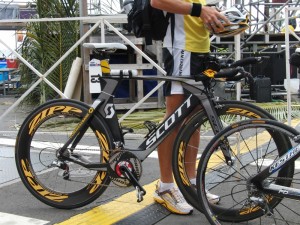
The Commerz Bank crew were very prominent with their new matching Scott Plasma 3’s done in in matte gray with yellow highlights. These are the same frames used by Pro Tour Team Columbia HTC in TT’s, and feature “sunken headsets” so that the trailing edge of the stem blends into the top tube. This works especially well with a level stem, but Mattias Hecht used an upright stem along with tall elbow risers. Hecht chose an Adamo like many pros this year, in this case a Podium. It also looks as if he opted for a Vittoria Pit Stop canister instead of carrying a tubular spare.
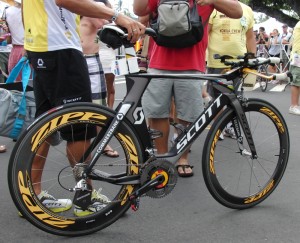
Normann Stadler’s Plasma was very similar, but sported very neatly coiled tubular spares under the saddle. Also note the aero rear derailleur jockey wheels, made by Berner. This looked to be the same setup used by Lance on his Trek TT bike.
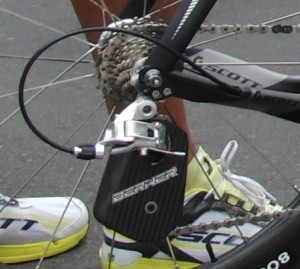
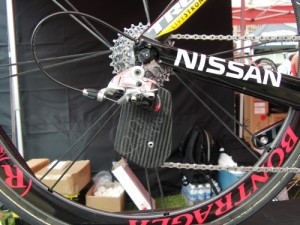
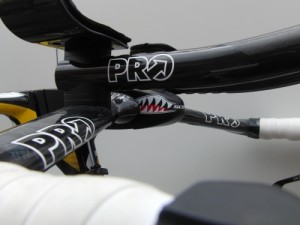
Eneko LLanos’s BH sported Hed Jet 9 clinchers and an unusual stem cap water bottle mount. This is probably a Hed Lollipop, but the bottle seems mounted even higher than the stem cap. Perhaps this is a wind tunnel revelation: maybe the high water bottle helps direct flow away from the rider’s torso, or maybe it’s just more comfortable. Completing the Hed suite are the Corsair aerobars.
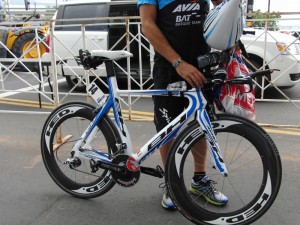
Timo Bracht was the renegade of the Commerzbank team, opting to ride a Giant Trinity. Timo used Q-rings, Di2, and like Hecht relied on a Pit Stop instead of a spare.
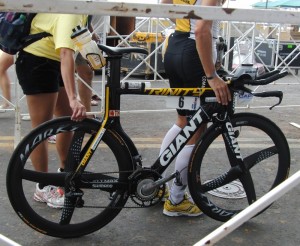
TJ Tollakson is by now well known for his one of a kind aerobar setup and mantis position. TJ has incorporated athletic supporter cups and shin pads to support his elbows and forearms in a nearly vertical position. He also has two water bottles mounted between the aerobars, for a grand total of 5 bottle cages. My guess is one or both of the aerobar bottles are decoys used for aerodynamic purposes. TJ has spent time tweaking this setup in the tunnel, and he must have found something worthwhile to bother with all this stuff dangling from his bars.
Aero-wise, once you have your frontal area minimized, the only thing left to exploit is shape. Remember that two objects with the same frontal area can have very different drag coefficients. An empty ice cream cone will have much less drag pointy end first vs. flipping it around open end first, even though the frontal area is the same. Downhill ski racers keep their hands up in front of their faces to make themselves more streamlined. TJ is trying to achieve the same thing with his high hands and bottlles filling in the gaps between his arms. It still looks super uncomfortable… Also note his helmet – no aero tail and in fact it doesn’t look like a road helmet at all. This could be an attempt to minimize drag via frontal area reduction. MIT studied aero helmets in the wind tunnel, and found that a bare head was actually more aero due to the greatly reduced frontal area – most aero helmets are much bigger than your head. So there is a case where reduced frontal area beats the more aero shape attached to a greater frontal area.
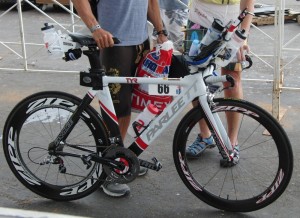
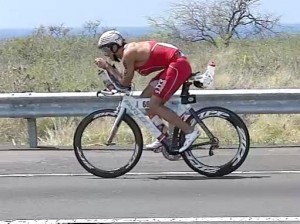

December 8, 2010 @ 9:25 pm
Is there something stuffed into TJ’s jersey?
December 9, 2010 @ 8:27 am
I hope so… probably sponges much like Macca’s 2007 Kona finish photos – but then again w/ TJ you never know if he has something in there for aero benefit